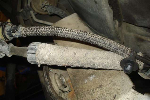jtb1689
Well-Known Member
- Joined
- August 23, 2008
- Messages
- 163
- Reaction score
- 0
- City, State
- Woodinville, WA
- Year, Model & Trim Level
- '93 Sport Eddie Bauer
I apologize in advance if there is already a thread on this, I searched, looked through the entire How To section, and haven't found quite what I'm looking for. (Though I find it hard to believe that there isn't a large number of people that have experience in this field)
So, after some time I have diagnosed various issues with my explorer and it is time for a head replacement. I was hoping to wait longer and upgrade heads, new cam, new lifters and rocker arms. But this needs to get done so I'm going with stock heads on my '93 and just getting her up and running.
Before I start this project this coming weekend I figured I would see if anyone had a few helpful tips here or there for anything unexpected they encountered or small things I may have looked over. My plan is really just to get in there and replace the heads with complete, new heads. I have all gaskets and heads waiting. Plan to soak the exhaust manifold bolts in a hefty amount of pbblaster.
So, any hints, tips, or tricks are welcome and very appreciated.
PS: Anybody got the torque specs for the heads? And I thought I read somewhere there was a certain tightening order as well...
So, after some time I have diagnosed various issues with my explorer and it is time for a head replacement. I was hoping to wait longer and upgrade heads, new cam, new lifters and rocker arms. But this needs to get done so I'm going with stock heads on my '93 and just getting her up and running.
Before I start this project this coming weekend I figured I would see if anyone had a few helpful tips here or there for anything unexpected they encountered or small things I may have looked over. My plan is really just to get in there and replace the heads with complete, new heads. I have all gaskets and heads waiting. Plan to soak the exhaust manifold bolts in a hefty amount of pbblaster.
So, any hints, tips, or tricks are welcome and very appreciated.
PS: Anybody got the torque specs for the heads? And I thought I read somewhere there was a certain tightening order as well...











